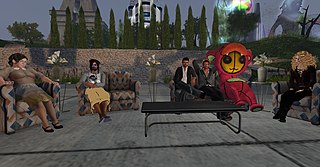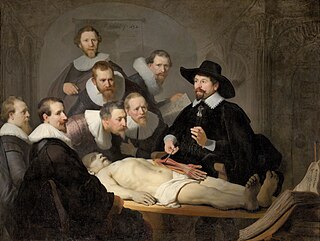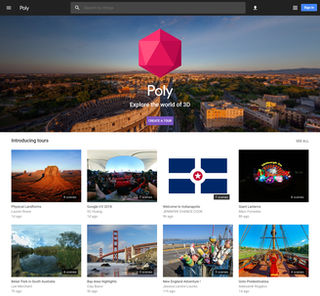Related Research Articles

Virtual reality (VR) is a simulated experience that employs 3D near-eye displays and pose tracking to give the user an immersive feel of a virtual world. Applications of virtual reality include entertainment, education and business. VR is one of the key technologies in the reality-virtuality continuum. As such, it is different from other digital visualization solutions, such as augmented virtuality and augmented reality.

The metaverse is a loosely defined term referring to virtual worlds in which users represented by avatars interact, usually in 3D and focused on social and economic connection.

Terminologia Anatomica is the international standard for human anatomical terminology. It is developed by the Federative International Programme on Anatomical Terminology, a program of the International Federation of Associations of Anatomists (IFAA).

In virtual reality (VR), immersion is the perception of being physically present in a non-physical world. The perception is created by surrounding the user of the VR system in images, sound or other stimuli that provide an engrossing total environment.
Primal Pictures is a business established in 1991 that provides 3D graphic renderings of human anatomy, built using real scan data from the Visible Human Project, for use by healthcare students, educators, and medical professionals. It operates the Anatomy.tv online platform. In one study, Anatomy.tv was deemed the greatest value in undergraduate anatomy education "since it had highest scores for effectiveness as well as the lowest scores for cost."
Professor Paul Gerard McMenamin is an Australian academic and researcher specialising in the structure and immunology of the eye.
A medical animation is a short educational film, usually based around a physiological or surgical topic, that is rendered using 3D computer graphics. While it may be intended for an array of audiences, the medical animation is most commonly utilized as an instructional tool for medical professionals or their patients.

Amira is a software platform for visualization, processing, and analysis of 3D and 4D data. It is being actively developed by Thermo Fisher Scientific in collaboration with the Zuse Institute Berlin (ZIB), and commercially distributed by Thermo Fisher Scientific — together with its sister software Avizo.

Oculus Rift is a discontinued line of virtual reality headsets developed and manufactured by Oculus VR, a virtual reality company founded by Palmer Luckey that is widely credited with reviving the virtual reality industry. It was the first virtual reality headset to provide a realistic experience at an accessible price, utilizing novel technology to increase quality and reduce cost by orders of magnitude compared to earlier systems. The first headset in the line was the Oculus Rift DK1, released on March 28, 2013. The last was the Oculus Rift S, discontinued in April 2021.

zSpace is a technology firm based in San Jose, California that combines elements of virtual and augmented reality in a computer. zSpace mostly provides AR/VR technology to the education market. It allows teachers and learners to interact with simulated objects in virtual environments.
Extended reality (XR) is an umbrella term to refer to augmented reality (AR), virtual reality (VR), and mixed reality (MR). The technology is intended to combine or mirror the physical world with a "digital twin world" able to interact with it, giving users an immersive experience by being in a virtual or augmented environment.
OpenVR is a software development kit (SDK) and application programming interface (API) developed by Valve for supporting the SteamVR and other virtual reality headset devices. The SteamVR platform uses it as the default application programming interface and runtime. It serves as the interface between the virtual reality hardware and software and is implemented by SteamVR.

Poly was a website created by Google for users to browse, distribute, and download 3D objects. It was launched in 2017 and intended to allow creators to easily share and access 3D objects. It featured a free library containing thousands of 3D objects for use in virtual reality and augmented reality applications.

The Edinburgh College of Medicine for Women was established by Elsie Inglis and her father John Inglis. Elsie Inglis went on to become a leader in the suffrage movement and found the Scottish Women's Hospital organisation in World War I, but when she jointly founded the college she was still a medical student. Her father, John Inglis, had been a senior civil servant in India, where he had championed the cause of education for women. On his return to Edinburgh he became a supporter of medical education for women and used his influence to help establish the college. The college was founded in 1889 at a time when women were not admitted to university medical schools in the UK.

There are many applications of virtual reality. Applications have been developed in a variety of domains, such as education, architectural and urban design, digital marketing and activism, engineering and robotics, entertainment, virtual communities, fine arts, healthcare and clinical therapies, heritage and archaeology, occupational safety, social science and psychology.

Studierfenster or StudierFenster (SF) is a free, non-commercial open science client/server-based medical imaging processing online framework. It offers capabilities, like viewing medical data (computed tomography (CT), magnetic resonance imaging (MRI), etc.) in two- and three-dimensional space directly in the standard web browsers, like Google Chrome, Mozilla Firefox, Safari, and Microsoft Edge. Other functionalities are the calculation of medical metrics (dice score and Hausdorff distance), manual slice-by-slice outlining of structures in medical images (segmentation), manual placing of (anatomical) landmarks in medical image data, viewing medical data in virtual reality, a facial reconstruction and registration of medical data for augmented reality, one click showcases for COVID-19 and veterinary scans, and a Radiomics module.
Immersive learning is a learning method which students being immersed into a virtual dialogue, the feeling of presence is used as an evidence of getting immersed. The virtual dialogue can be created by two ways, the usage of virtual technics, and the narrative like reading a book. The motivations of using virtual reality (VR) for teaching contain: learning efficiency, time problems, physical inaccessibility, limits due to a dangerous situation and ethical problems.
RobotLAB is an American educational technology company that manufactures robotics and virtual reality products for K-12 and higher education, as well as business robots for retail, hospitality, and medical companies. The company distributes the Pepper and NAO humanoid robots developed by SoftBank Robotics. They are headquartered in Dallas, Texas.
The Visible Embryo Project (VEP) is a multi-institutional, multidisciplinary research project originally created in the early 1990s as a collaboration between the Developmental Anatomy Center at the National Museum of Health and Medicine and the Biomedical Visualization Laboratory (BVL) at the University of Illinois at Chicago, "to develop software strategies for the development of distributed biostructural databases using cutting-edge technologies for high-performance computing and communications (HPCC), and to implement these tools in the creation of a large-scale digital archive of multidimensional data on normal and abnormal human development." This project related to BVL's other research in the areas of health informatics, educational multimedia, and biomedical imaging science. Over the following decades, the list of VEP collaborators grew to include over a dozen universities, national laboratories, and companies around the world.

Qlone is a 3D scanning app based on photogrammetry for creation of 3D models on mobile devices. The resultant 3D models can be exported for external use.
References
- ↑ "HOME". 3D ORGANON. Retrieved 2024-09-05.
- ↑ Lilly J (April 2022). "3D Organon VR Anatomy". Journal of the Medical Library Association. 110 (2): 276–278. doi:10.5195/jmla.2022.1341. PMC 9014920 . PMID 35440904.
- ↑ Weyant EC, Woodward NJ (2021-10-02). "3D Organon VR Anatomy: A Virtual Anatomy Medical Education Tool". Journal of Electronic Resources in Medical Libraries. 18 (4): 198–203. doi:10.1080/15424065.2021.2000911. ISSN 1542-4065.